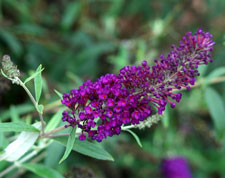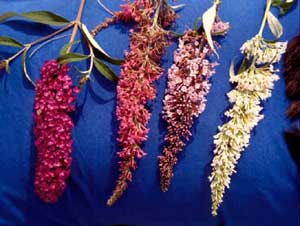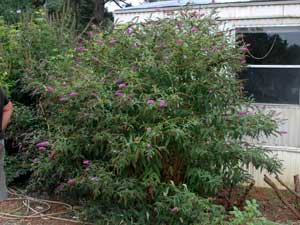Landscape Shrubs
Butterfly Bush
(Buddleia (Buddleja) davidii)
It is interesting how often gardeners look for plants that require lots attention and care while overlooking others that are almost indestructible. Butterfly bush (Buddleia davidii) is in this later category. Adaptable to gardens as far north as Boston and as far south as Florida, this group of plants offers a wide diversity in flower color, leaf color and texture, and plant size.
Butterfly bush is a classic summer flowering shrub. Depending on the cultivar, it can start flowering in June and may continue flowering until late fall. While the individual tubular flowers are small, they are clustered together in large, upright, or nodding panicles that are cone-shaped. Flower colors range from white (‘Peace,’ ‘White Bouquet’), to pink (‘Pink Delight’), blue/lavender (‘Ellen’s Blue,’ ‘Empire Blue’) and regal purple (‘Black Knight,’ ‘Purple Emperor’). Some breeders are striving to get a true red. Cultivars such as ‘Attraction’ and ‘Royal Red’ seem to be getting us closer. A common garden reference lists over 65 cultivars.
The quality of the flower display would benefit from deadheading, but who has time for that kind of care? In this species, flowers are born on new wood, so you can be quite aggressive with your pruning in the spring (renewal pruning) and still have a nice flower display in the summer. While it should be no surprise that Buddleia is a cornerstone plant for attracting butterflies to your garden, some gardeners may be surprised by how fragrant the flowers are on some cultivars.
Because of the wide diversity in selections, it is hard to give one single description for the leaves. Leaves, which are arranged in an opposite fashion on stems, are typically large (4 to 8” long, 1” to 3” wide), coarse in texture, with a serrated (teeth-like) leaf edge, and a gray-green to dark green color. There will be no fall color on butterfly bush. Leaves tend to hold until a hard freeze.
Culture is easy for butterfly bush. This plant thrives on full sun and is very drought tolerant once established.
Plant size is hard to pigeon-hole, since again, we are talking about a large number of cultivars. In general we would classify butterfly bush as a large shrub (10-12’ tall, similar spread). Many selections are in the range of 6-8’ tall.
A major concern surrounding butterfly bush in the United States and abroad is the potentially invasive nature of the plant. Even in its native China, butterfly bush is frequently found colonizing disturbed sites. A number of breeders are trying to produce sterile (fruitless) selections. The University of Arkansas introduced ‘Asian Moon,’ a sterile selection, in 2006.
The genus name may be found spelled several ways in the trade or literature. While many spell the genus name with a j, (Buddleja), others spell it with an i (Buddleia). A few use Buddlea. The genus name honors an English botanist, Adam Buddle.
If you are looking for a very easy-to-care-for shrub that adds lots of flower color (“bang for your buck”), you might want to consider butterfly bush in your full sun garden.
- Common Name: Butterfly bush, summer lilac
- Varieties to look for: ‘Pink Delight,’ ‘Attraction,’ ‘Black Knight,’ ‘Peace’
- Flower Color: white, pink, purple
- Blooming period: summer
- Perennial or annual: deciduous woody shrub
- Size: 10’ tall by 10’ wide
- Exposure: full sun
- Soil: adaptable
- Watering: tolerates dry
- When to prune: early spring
- Suggested use: mixed shrub border
Flower structure

Flower varieties

Form with flowers
